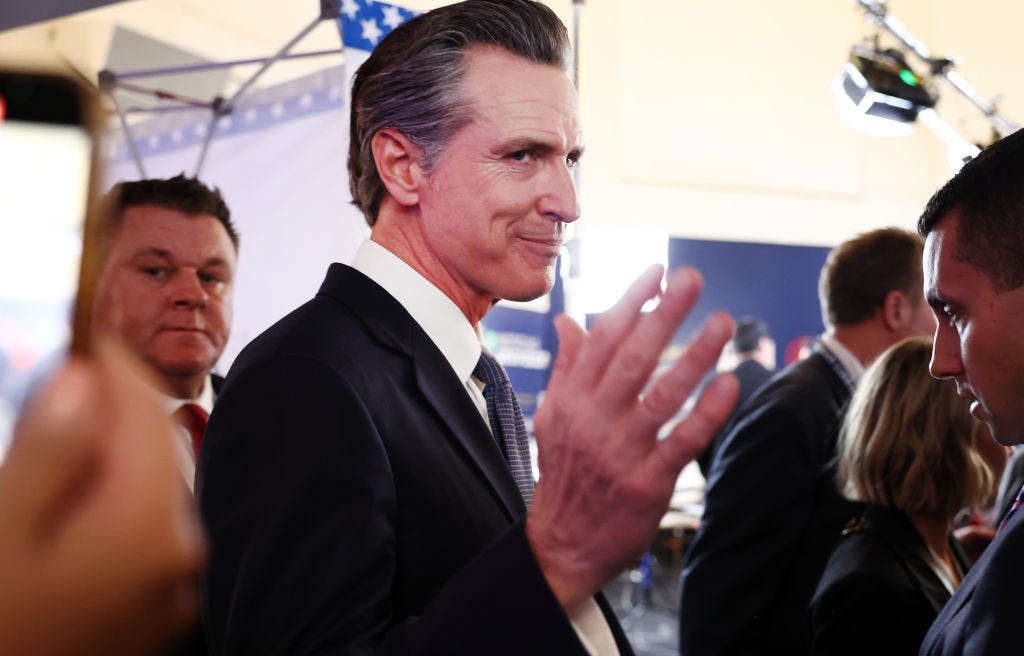Substacks
Book Club: The Triumph of the Yuppies Peter Savodnik
Last month, we launched The Free Press Book Club, in which one of our writers recommends a new book they love along with a classic work from the past echoing its themes.
In May, Nellie Bowles praised P.J. O’Rourke’s Parliament of Whores—and the joys of political satire—and paired it with, what else? Her own book, Morning After the Revolution. (Did we mention it became a New York Times bestseller?)
Today, Free Press columnist Peter Savodnik picks Triumph of the Yuppies by Tom McGrath, who argues that the rise of the “young urban professional” in the ’80s corrupted America for good. Peter is matching this book with the classic Bright Lights, Big City by Jay McInerney, who became the unofficial “spokesman for the yuppies” after publishing his breakout novel in 1984.
Below, you’ll find an essay from Peter about how yuppies came to be such an influential and corrosive force in our culture—ultimately leading to the election (and possible reelection) of Donald Trump. And if you’re a paid subscriber, we have a special treat for you. At the end of this piece, you can watch Peter in conversation with Tom McGrath and Jay McInerney about the legacy of the yuppie. They discuss Boomers, Wall Street, the culture of consumerism, a few questions from Free Press readers, and ultimately, they answer the bigger question: What can yuppies teach us about America today?
If you’re not already a paid subscriber, become one now to join our monthly book club. You can watch Peter’s conversation, comment on this essay, and get invited to future in-person book club events. (More on that later!):
Meanwhile, send us your thoughts about yuppies at books@thefp.com, and consider buying Bright Lights, Big City and Triumph of the Yuppies from the good people at Bookshop, where every purchase through these links earns a commission for The Free Press. Or if you’re an Amazon customer, click here for Tom’s book or here for Jay’s.
And now, here’s Peter on the Triumph of the Yuppies:
My wife and I were at a dinner party a few months ago, in the Hills, in Los Angeles.
Everyone was in their late 40s or early 50s, and there was a weariness that permeated the conversation—no one wanted to talk about the election, or the border, or China, or AI, or the encampments, or even Ozempic (which, I suspect, two or three people there were injecting regularly). Instead, we talked around the news. There was a vague longing for The Great Before. Before the screens, the brands, the narratives, the curators, the audience-builders. Before there was a conspiracy theory, or theories, swirling around literally everything.
The Great Before—“the time before everyone went crazy,” as our host put it—is the quasi-mythological, prelapsarian America we grew up in: the ’80s.
This is the thing you need to bear in mind about the ’80s: the gargantuan, unapologetic success of it all.
It wasn’t just about money. It was about ostentatiousness, and, really, the celebration of ostentatiousness. “Material Girl” was a hit. Family Ties was a hit. Working Girl was a hit, with its famous, wince-inducing line, uttered by Melanie Griffith: “I have a head for a business and a bod for sin—is there anything wrong with that?”
It was also about the American Dream—which had been battered by Vietnam, stagflation, crime, the Soviet invasion of Afghanistan, the Iranian storming of the U.S. embassy—suddenly rising once again. It was morning in America, as Ronald Reagan reminded us, and the problem was not us, but the communists and big government.
The subtext of all this amounted to an updated social Darwinism: our things were a testament to our national superiority, and our duty as Americans was to keep acquiring them. If we didn’t, could we really say we were superior to everyone else?
All of which is to say that it was not a terribly introspective moment.
Had it been more introspective, we might have realized that the rampant materialism of the yuppie led to a division that now threatens to undo our republic.
That is the suggestion of my Free Press Book Club pick today: Tom McGrath’s Triumph of the Yuppies: America, the Eighties, and the Creation of an Unequal Nation. While a lot of people made a great deal of money in the ’80s, McGrath writes that the era also fundamentally changed the country for the worse. And we are still living inside that country—whether we realize it or not.
Specifically, he argues that America, “in its push to revive itself, in its zeal to recapture the dominance and prosperity of the postwar era,” ultimately ended up “elevating self-interest over any sense of the common good.” In short, “the country had created a new economic and social order that wouldn’t easily be undone.”
We all know what the yuppie looks like—he’s the guy in the Hugo Boss power suit with the pocket square, the Rolex, the monogrammed silk suspenders, crushing it with his fellow investment bankers, throwing back gin buck cocktails at the Harvard Club.
But where did this chump, with his unslakable shallowness, come from?
In the late 1970s and early ’80s, immediately prior to the rise of the yuppie, there was—imagine this, young people of 2024!—a great deal of anxiety about the future.
“The economic burden fell particularly hard on the Baby Boom generation, who were twice as likely to be unemployed as their parents had been in the ’50s and who, even if they had jobs, hardly felt like they were getting ahead,” McGrath writes. Adjusted for inflation, he notes, young people’s salaries actually decreased by $300 annually from 1970 to 1980.
This anxiety, he argues, led to a renewed focus on money and ambition and making all the right decisions—about where one went to school, what one majored in, where one moved after college.
Or who one married, according to the yuppies quoted in McGrath’s book.
Like 28-year-old Robert Drumheller, who told Newsweek in 1981, that “it was very important for me to marry a professional person. One of my goals was to have a high standard of living, and with two incomes you get to the easy life much faster.”
All of a sudden, there was a race for jobs and promotions and spouses, and a relatively small number of young people surged ahead. In 1985, the Chicago Tribune estimated there were 4.2 million yuppies, or 5 percent of all Baby Boomers. Everyone else had been left behind. The era of shared, widespread, upward mobility that had characterized the ’50s and ’60s and petered out in the ’70s, was officially over.
Yuppie America, McGrath told me, was “where you really start to see this divide in America along economic and educational lines.”
It was in May 1980 that the journalist Dan Rottenberg, writing in Chicago magazine, coined the term yuppie, McGrath writes.
But it would take a few years before the public really became aware of this phenomenon—and before the phenomenon became aware of itself.
Then, in September 1984, Vintage Books published Jay McInerney’s Bright Lights, Big City, catapulting McInerney—then 29 and living on Manhattan’s Lower East Side—into something of a star.
“I woke up one morning right after the book was published,” McInerney told me, “and it was published to very little fanfare initially, but The Wall Street Journal picked up on it very quickly, and they announced that I was the spokesman for the yuppies, which kind of horrified me.”
Interestingly, the term yuppie never appears in Bright Lights, Big City. In 1983, when he wrote the novel, it was not yet popular; by the time the novel came out, McInerney said, “We were deep in the middle of this thing.”
In Bright Lights, McInerney’s unnamed, second-person protagonist, who inhabits the periphery of the yuppie universe, offers the first vivid account of this emergent, slightly horrifying species.
On the one hand, he is a New Yorker fact-checker and an aspiring novelist who fashions himself a man of letters—definitely not a yuppie. On the other hand, McInerney said, the protagonist’s best friend-slash-coke dealer, Tad Allagash, “has really no values except having more fun than everybody else and looking good while doing it, so there’s no question that I was chronicling that world.”
After Bright Lights, Big City took off—Triumph of the Yuppies notes that it sold 10,000 copies in its first three weeks and New York City bookstores couldn’t keep it in stock—McInerney had to change his phone number.
“People were calling me up to ask me advice on how to get to these various places” that he wrote about in the novel, “including quite a number that I just made up,” McInerney said. “There is no Lizard Lounge, but a lot of people wanted to know what street it was on.”
McInerney told me the new yuppie materialism amounted to “a rejection of parental values”—TV dinners, the suburbs, all the assumptions that had governed postwar, middle-class life.
What distinguished this boom time from previous boom times, McGrath added, was not simply the ferocity with which yuppies went about buying their Porsches and Cuisinarts and Julian Schnabel paintings and pretty much everything at Sharper Image. It was the nature of the materialism itself.
Earlier generations of Americans had subscribed to an “inclusive materialism,” McGrath told me—it was “a keeping up with the Joneses era,” when everyone shopped at Sears. But for yuppies, “it’s more of an exclusive materialism. ‘I’m going to own this thing, because most people do not have it, and it’s a way of setting myself apart, as opposed to a way of being part of the community.’ ”
“A new generation of young professionals wanted something more, something less common. The buzzword that people started using was quality. The things they purchased would be, like the lives they were trying to create for themselves, excellent.”
By 1985, the anti-yuppie backlash had begun. DIE YUPPIE SCUM started to appear on buildings and streetlamps downtown.
Then, on October 19, 1987, the stock market crashed—with the Dow Jones losing nearly 23 percent of its value, or $500 billion, in a single day. The era of the yuppie was apparently dead.
McInerney smirked when I suggested as much. “Yuppie culture is like the undead,” he told me. “It persisted and thrived and metamorphosed.”
In fact, both authors noted that the spirit of the yuppie is now alive and well in the ur-yuppie known as Donald Trump. Ironically, his 2016 election came about, McGrath writes, because “families at the top of the economic pyramid controlled 79 percent of all wealth in America, up from 60 percent in the 1980s.”
By then, the long-percolating anti-yuppie sentiment in blue-collar America had curdled into an angrier anti-elitism.
And the billionaire Donald Trump “somehow persuaded many working-class Americans that he was on their side.”
I loved talking to both of these writers and reading Triumph of the Yuppies and rereading Bright Lights, Big City. If you’d like to learn more about New York in the go-go ’80s, Ivan Boesky, Tad Allagash, the story behind the rise of Madonna, and Bolivian Marching Powder (read the novel, people), scroll down:
To listen to Peter’s discussion with Tom McGrath and Jay McInerney, become a subscriber today. You’ll also be able to continue the conversation in the comments.
Substacks
Gavin Newsom Won’t Save the Democrats Nellie Bowles

This piece was first published in our news digest, The Front Page. To get our latest scoops, investigations, and columns in your inbox every morning, Monday through Thursday, become a Free Press subscriber today:
The quick-witted, smooth-talking governor of California would be an obvious pick for Biden’s replacement—in some ways. Gavin Newsom has been Biden’s surrogate throughout the campaign, and he’s good at it, always appearing vigorous and alive, seeming to genuinely enjoy sparring with Republicans. He’s charming; he’s dashing; he’s funny. And he runs the most important state in the union, California, the world’s fifth-largest economy. You can complain about its politics all you want (I do, I have, I will in the following paragraphs), but the numbers don’t lie: the state is a world power unto itself. Plus, there is his age. Newsom looks like a teenager next to our gerontocracy. He is only 56 years old. Sure, that’s about ten years older than Bill Clinton and Barack Obama when they began their terms, but that’s not what matters. To our eyes now, adjusted for Trump and Biden, a 56-year-old president is basically a teen mom—shocking, wild, vibrant.
You know what else is going in Gavin Newsom’s favor? His ex-wife is Donald Trump Jr.’s fiancée, which is funny, strange, and definitely falls in the pro column. Plus, he’s managed to wrangle the rest of California’s political class of corrupt communists without ever seeming too corrupt or too communist himself. He’s done some vaguely moderate things. I do believe Gavin Newsom believes in the free market, and that’s a big deal for an elected Californian in the year 2024.
But Gavin Newsom would probably fail as a Biden replacement. Because he does, I’ve heard, have weaknesses. What are they?
Well, there’s the homelessness situation. California’s cities are overrun with tent encampments. Root causes: lack of cheap housing thanks to “environmentalists” and neighborhood heritage types who block anything that’s not a single-family home, preferably with a chicken run out back. Also: empathetic-seeming but insane drug policies that all but pay people to do more fentanyl.
There’s the high-speed rail. This boondoggle has so far cost $18 billion across 15 years, with no train in sight, though the project randomly announces a few feet of track has been laid in a desert every couple years. The top railroad operator in France was supposed to help build it before abandoning the state to build one in a region that was “less politically dysfunctional” (that region: North Africa).
There’s the fact that California’s required ethnic studies courses are pretty antisemitic. There’s the fact that Newsom was eating indoors with all his friends at the French Laundry during the pandemic when everyone else was banned from indoor dining. I mean, don’t even get me started on Gavin’s lockdown policies.
As for the top issue on many voters’ minds: he’s not exactly an Abolish ICE guy, but he’s not particularly strong on the border. You’ve heard of sanctuary cities, but Newsom wants the whole state to be “a sanctuary to all who seek it.” Which is a lovely notion but. . . the entire world would like to move to California for a little Santa Monica sanctuary.
Personally, I like Gavin. (Stop throwing things at me, I am who I am!) But he’s too vulnerable on too many hot-button national topics right now, and I think the DNC knows that.
Nellie Bowles is the author of The Free Press’s legendary Friday column, TGIF. She’s also just published a book, Morning After the Revolution. Read an excerpt, “The Day I Stopped Canceling People,” here. Follow her on Twitter @NellieBowles.
Substacks
Chefs Make Us Eat Their Inner Lives Tanya Gold

This piece was first published in our news digest, The Front Page. To get our latest scoops, investigations, and columns in your inbox every morning, Monday through Thursday, become a Free Press subscriber today:
I am a restaurant critic, and in 2018, I ate at what had just been named the best restaurant in the world. Osteria Francescana, in Modena, is run by the famous chef Massimo Bottura, and to dine there feels like eating his internal life. His memory of a childhood holiday in Normandy was lamb, kelp, and cider; his description of autumn in Northern Italy was mushrooms, chestnuts, and truffles. It was not unpleasant, but it was odd, with an intensity I just don’t want from food.
I kept eating because the meal would cost the newspaper I was writing for a fortune, and it would be rude not to, but my digestive system was a victim and a pawn. The dish I liked best was the lasagna. It was a tiny moment of sanity—too tiny. A portion for ants.
But that is the tasting menu restaurant for you: an invitation to a chef’s inner life. It isn’t about you and the food you love: it’s about them and their desire to impress and remake the world on tiny plates. That is what I think when I watch The Bear, which has just reemerged for its third season.
It follows Carmen Berzatto—a highly trained chef, played by Jeremy Allen White, who has returned home to Chicago to turn his recently dead brother’s sandwich shop into a restaurant worthy of a Michelin star. People loved the sandwiches: they queued around the block for them. They only admire Carm’s would-be Michelin-starred food. There’s a difference and I think it’s this: the first satiates the diner. The second satiates the chef.
In flashbacks, we see that Carm got his start at a restaurant in New York City. Its kitchen is like an operating theater. I think it’s based on either Per Se or Eleven Madison Park, tasting menu palaces that Michelin stars fall on like snow. The former is run by Thomas Keller, who has a cameo in this season of The Bear. Working in this restaurant, Carm is tortured by the head chef. In Season 3 they meet again, and he tells Carm he needed to be tortured to be great.
What becomes of this torture? I have reviewed both restaurants. Per Se, I hated. I thought it pretentious and loveless, a glossy cave above Columbus Circle, preening with self-love, serving quite repulsive food. Sitting before Keller’s plates, I thought: What does this food, so tiny and overwrought, have to do with me? Why am I eating a panic attack that isn’t my own? When I got back to the hotel, I threw up.
Daniel Humm’s Eleven Madison Park was better: that is, I didn’t feel actively hated there. It was just weird. The duck with lavender flying from its ass was good, but unnecessary. I don’t know what Humm’s variations of turnip were trying to do. Perhaps Humm was trying to save the turnip—but why elevate it above all root vegetables?
Food can do anything—Massimo Bottura told me that—and I want chefs to do less with it. I love these guys, I admire them, I pity them. But for all I have eaten, the meal I loved best was red snapper, pulled from the Caribbean Sea, and cooked in a shack only half rebuilt after a hurricane. It had a simplicity and an honesty to it. That is, it was happy to be itself.
Tanya Gold is an award-winning freelance journalist. Follow her on X @TanyaGold1. And read her piece for The Free Press, “Dubai Paid Beyoncé $24M. She Gave Them Her Integrity.”
Substacks
The reclusive plutocrat who became the biggest political donor of 2024 Judd Legum

The largest donor of the 2024 presidential campaign, by far, is Timothy Mellon, the reclusive billionaire and heir to the Mellon banking fortune. Mellon was already the largest donor after donating $25 million each to the Super PACs supporting the presidential campaigns of Donald Trump (MAGA Inc.) and Robert F. Kennedy Jr. (American Values 2024). Then, Mellon donated another $50 million to MAGA Inc. on May 31, the day after Trump was convicted of committing 34 felonies.
Mellon’s $75 million contribution to MAGA Inc. represents almost half of the group’s total fundraising. Mellon has also donated millions more to other conservative causes this cycle.
Despite his political spending, little is known about Mellon. The most detailed account of Mellon’s views comes from his self-published 2015 autobiography. “This book was not ghost-written: every single word is my own,” Mellon said in a press release announcing its publication. People who wanted to purchase the book were required to make a $9 donation to Hillsdale College, a private Christian institution that aggressively promotes right-wing ideology or another conservative group.
According to a 2020 article published in the Washington Post, Mellon writes that Black people have become “even more belligerent and unwilling to pitch in to improve their own situations” after social safety net programs were expanded in the 1960s and 1970s. Mellon writes that they are now “slaves of a new Master, Uncle Sam.”
Mellon also derided programs intended to lift people out of poverty as “Slavery Redux.” Mellon claimed that in exchange for “delivering their votes in the Federal Elections, they are awarded with yet more and more freebies: food stamps, cell phones, WIC payments, Obamacare, and on, and on, and on.” According to Mellon, who inherited his fortune, “[t]he largess is funded by the hardworking folks, fewer and fewer in number, who are too honest or too proud to allow themselves to sink into this morass.”
Mellon also blasted universities for offering college students the opportunity to learn about the history of Black people, women, and the LGBTQ community. “Black Studies, Women’s Studies, LGBT Studies, they have all cluttered Higher Education with a mishmash of meaningless tripe designed to brainwash gullible young adults into going along with the Dependency Syndrome,” Mellon wrote.
In response to scrutiny of the book, Mellon stood firm. “I said everything I wanted to say,” Mellon told Bloomberg. “I don’t have any regrets.”
But now, Mellon is trying to rewrite history. The website Mellon used to sell the book, timsstory.com, has been taken offline. The book doesn’t appear to be available to purchase anywhere. Instead, later this month, Mellon is publishing a new autobiography with the same title. This time, the cover includes a gushing blurb from Kennedy.
Mellon’s new book is being published by Skyhorse Publishing, which is run by Tony Lyons. He also serves as the co-chair of American Values 2024, Kennedy’s Super PAC. Skyhorse Publishing has published Kennedy’s books about vaccine conspiracy theories and the works of other conspiracy theorists, including Alex Jones. According to the promotional material, Mellon’s new book reveals “a life not merely lived on inherited wealth but on conviction, leadership, and the audacity to defy convention.”
Mellon’s connection to Project 2025
In addition to his donations to Super PACs supporting the campaigns of Trump and Kennedy, Mellon donated $4 million to Sentinel Action Fund, a Super PAC created by Heritage Action, a subsidiary of the Heritage Foundation. (Contributions directly to Heritage Action or the Heritage Foundation are not disclosed.)
The Heritage Foundation is the leading organization behind Project 2025, a blueprint for a second Trump administration.
Project 2025 is a 920-page document that lays out a radically different future for the United States. The document details a “Christian nationalist vision of the United States, one in which married heterosexuality is the only valid form of sexual expression and identity; all pregnancies would be carried to term, even if that requires coercion or death; and transgender and gender-nonconforming people do not exist.”
In addition to the detailed policy guide, the Heritage Foundation is vetting thousands of “conservative warriors” who can come to Washington, D.C., to implement the plan.
Why is Mellon supporting Kennedy?
Mellon’s $25 million donation to Kennedy’s Super PAC is keeping his cash-strapped campaign afloat. But why is Mellon supporting Kennedy?
In 2023, before Kennedy dropped out of the Democratic primary, Mellon expressed his support for Kennedy in a statement released by the super PAC. “The fact that Kennedy gets so much bipartisan support tells me two things: that he’s the one candidate who can unite the country and root out corruption and that he’s the one Democrat who can win in the general election.” Mellon “has also been a ‘supporter’” of Kennedy’s anti-vaccine non-profit Children’s Health Defense, Mark Gorton, co-founder of the American Values super PAC, told NOTUS.
Mellon, however, also has a history of supporting candidates that he thinks will damage the Democratic Party.
In 2018, for example, Mellon donated $2,700 to Representative Alexandria Ocasio-Cortez (D-NY). In an interview with Bloomberg, Mellon explained the donation was because “he thought that, if elected, her outspokenness would cause headaches for Democrats.” Ocasio-Cortez’s campaign tried to refund the donation, but Mellon said he would “neither cash nor deposit the check but rather, frame it.” The Wall Street Journal reported that Mellon also donated $5,800 to Senator Joe Manchin (I-WV) in 2021 and 2022 and $2,900 to Senator Kyrsten Sinema (I-AZ) in 2022, two politicians who have a history of obstructing Democratic policy priorities.
Mellon’s other massive donation
In 2021, Mellon donated $53 million to Texas Governor Greg Abbott’s (R) fundraising campaign to build a border wall. According to the Texas Tribune, Mellon’s donation “contributed nearly 98% of the fund’s total donations.”
In June 2021, Abbott announced a plan to build a state-funded wall on the Mexico border. Abbott “expected people to both donate their own money and volunteer their land for the barrier.” The plan is part of Abbott’s Operation Lone Star, which seeks to subvert federal immigration policy. In addition to the barriers, some of which are topped with razor wire, Texas has authorized “Texas National Guard soldiers and state troopers to arrest” undocumented migrants. This has created safety concerns and “essentially criminalizes seeking asylum,” which migrants have the right to pursue under federal law.
The Wall Street Journal reported that “people familiar with [Mellon’s] thinking” said that “[o]ne of the main issues driving Mellon’s giving is immigration.” In 2010, Mellon gave $1.5 million “to help the state of Arizona defend a controversial law that required police to determine the immigration status of people suspected of living in the U.S. illegally, which critics said could lead to racial profiling.”
-

 Awakening Video10 months ago
Awakening Video10 months agoThis is What Happens When You Try to Report Dirty Cops
-

 Substacks3 months ago
Substacks3 months agoTHE IRON-CLAD PIÑATA Seymour Hersh
-

 Substacks9 months ago
Substacks9 months agoThe Russell Brand Rorschach Test Kathleen Stock
-

 Substacks10 months ago
Substacks10 months agoA real fact-check of Trump’s appearance on Meet the Press Judd Legum
-

 Substacks8 months ago
Substacks8 months agoLetter to the Children of Gaza – Read by Eunice Wong Chris Hedges








